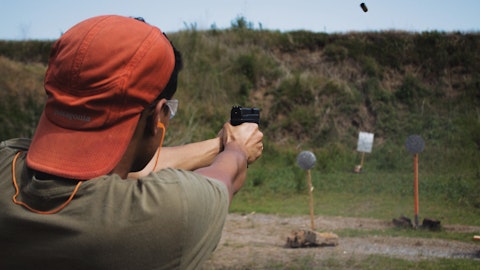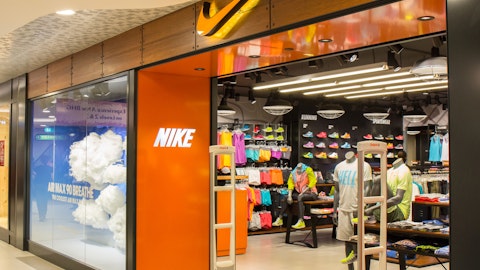And for us, the merchants, the operators, our visual team to ensure we’re doing everything we do have stores that are not performing at the level we need to be able to get them back in the shape that we need. But ultimately, I would just flip that and say we want to be able to get the balance sheet in a great position this year as we pay down debt and we generate free cash flow and then put ourselves in a position in ’25 and then particularly in ’26, so where we can go and start growing.
Justin Kleber: Well, thanks for the time and best of luck.
Operator: Our next question comes from the line of Anna Glaessgen with B. Riley Securities.
Anna Glaessgen: Thanks for the detail on camp and fish, really helpful putting that in perspective. I just wanted to clarify, you noted positive trends in the categories. Are you seeing like year-over-year positive growth or just sequential improvement from the most recent quarters?
Jeff White: From what we’re seeing right now in the market is year-over-year growth, and it really goes back to what Paul talked about, if we think back to last year, not only was the season late because of the weather, but we also were not in a position to invest in the right goods and have them in the right place in the right time. This year, we were setting those areas of the business much earlier as soon as January and February. So not only have we beat seasons, we were the first to market in it. The stores are in great shape, a good in-stock position. So we’ve really set ourselves up for the trends that we’re seeing, and we’re seeing the fruits of the labors right now as we sit here today.
Riley Timmer: I would say the other thing just on that, Anna, is we’re just, we’re really seeing positive results around newness and depth and that the most important thing on newness and depth is we’re getting an opportunity to be more local, more regional and the team did a great job as they went in particular in fish and camp. How can we hit the mark in the different geographies and be able to get more local than what we’ve been. And we have taken our eye off the ball there. So I think the exciting thing for the consumer and what the stores are seeing out there today is that as the team worked at the back end of Q4, they were able to keep their eye on the local regional component, and you’re getting to see that. And I think the other thing that I would add to it is we’ve got a lot more space as we went through the inventory reduction process, we really were strategic on being able to open up space and feature space where we needed to open it up.
And the line of sight for our features we are in and for our dry valves to be able to bring that store out, to bring those items out and bring them to life in the store. Much, much different than what we’ve ever had in the past. So I think being able to be really productive with every square foot of the store. We’re excited about what that looks like. And at this point, we touched just about every area as we finish out March and resetting and being able to open up the stores and give us the additional feature space we needed to, so we can showcase the newness.
Anna Glaessgen: Great. And turning to apparel footwear, you’ve been clear about clearing some of that distressed inventory and the need to reset that category. What do you think is the appropriate time line to think about when you’ll be presenting fully reset assortment in those categories.
Riley Timmer: I mean we’re in the — it’s flowing today, and I mentioned that we reset every part of the store. That was really through the gondolas as we think of camp fish and hunt. And then right now, we’re in the process of resetting setting up the shops that we have and that you’re going to see the spring colors in a much better place. Ultimately, as we come into really our peak as we get into fall and you see our fall season and then we go into the holidays with that buying team really being able to lean into it you’re going to start to see it as you get into spring and summer, but you’re really going to be able to see the impact as we get into fall.
Operator: Next question comes from the line of Mark Herrmann with R5 Capital.
Mark Herrmann: You gave out some numbers about the fishing SKUs and vendor rationalization. I just want to clarify, are those are before you added back any depth of product. Is that right? And kind of what is the permanent change in the SKUs and vendors look like in both fishing and the overall business? If you can kind of quantify that.
Paul Stone: No, I think it’s at the same time. I mean, you’re going through the rationalization process, but as you’re putting your buy in. The team did a really good job of being able to get down in front from a clearance standpoint and get out of the old distressed goods even in fish. And then as we came back, we were able to go and you can see in the stores today with much, much greater depth. So I think they both go hand in hand, the distressed inventory moving at and then us being able to really, really go into debt fullness key items and the investment that we were able to see. And that’s inclusive of us bringing in, as we talked about that SKU assortment and rationalization that’s inclusive of being able to be more regional and local as we buy as well.
Jeff White: Yes, Mark, this is Jeff. As we think about — as we move through the inventory last year in totality across the business, we’ve removed roughly about 20% of our SKU assortment and vendor assortment out in totality across the business. What that does is allow us to go deeper and more meaningful with key vendors that resonate with our customer. And that’s what’s really driving that’s what drove the efforts behind the scenes is making sure, again, back to the right goods, the right place for the right seasons with the right vendors. And that’s what has changed about how we think about the business going forward.
Paul Stone: I think the energy and the feedback that we’re receiving from our partner and supplier community on the strategy and being able to be very targeted on approach and buying in the depth is — it’s been welcomed and it allows us to be able to manage the product. And regionally, as we’ve restructured our field organization to align from a geography standpoint, it’s given us the opportunity, I think, to really double down.
Mark Herrmann: So in apparel and footwear given the discounting, would you say that the kind of the non-go-forward brands and styles would also be maybe somewhere in that 20% range kind of long term for those 2 categories? Or how much of the fourth quarter discounting is permanently element.
Jeff White: A lot higher than that for apparel and footwear, Mark. That’s why we had to specifically call those out last year. If you notice, we haven’t called out some of the other categories because we’ve been able to get out of those vendors without having it be materially impactful to the business. Apparel and footwear was much, much higher than that, which is why the call out last year was necessary to make because it was going to be very significant for the overall profitability of the business.
Mark Herrmann: Okay. Great. Just one last thing. We haven’t heard about private label in a while. Have your goals changed at all for that? And have you thought about focusing even more there, just given the consumer trade down comments you made today?
Riley Timmer: Yes. I think it’s always top of mind. And as we look at it as a management team, we want to ensure we do this right. And it takes a team and it take processes to be able to truly build out the private label. You’ll see that improve this year. But I think as we look at it overall, we need to be thoughtful. We need to be extremely strategic. And most importantly, I think the team here, we’ve seen what great private label looks like within our industry, and we’ve also seen what private label should never look like within the categories which we serve and the consumer we serve. So we’re going to put our name and we are, and we’re going to put Sportsman’s Warehouse on it, we have to ensure that we have the quality and standards and expectations we need.
It’s front of mind for us. We want to make sure as we go through this journey with private label that we’re doing it right, that we do not lose credibility with the consumer and they can look back and go. Man, this is true quality gear that you’re getting here. So I would tell you, it’s front of mind as we think about the build out over a period of time. We’ve just got to be really thoughtful and strategic. But you will start to see it. I’m really pleased with some of the things that we’re working on right now and you’re going to see the back half of the year that you’re going to have. But ultimately, I mean, we are a house of brands. Our consumer depends on that. But we do think that we can mix and that we have an opportunity and a right to win to be able to bring a quality private label to market.
Operator: There are no further questions at this time. I would like to turn the floor back over to Paul Stone for any closing comments.
Paul Stone: Thank you for joining the call today, and thank you to all the passionate employees around the country for your commitment to Sportsman’s Warehouse together. We look forward to providing our customers with great gear and exceptional service. Thank you.
Operator: This concludes today’s teleconference. You may disconnect your lines at this time. Thank you for your participation.





